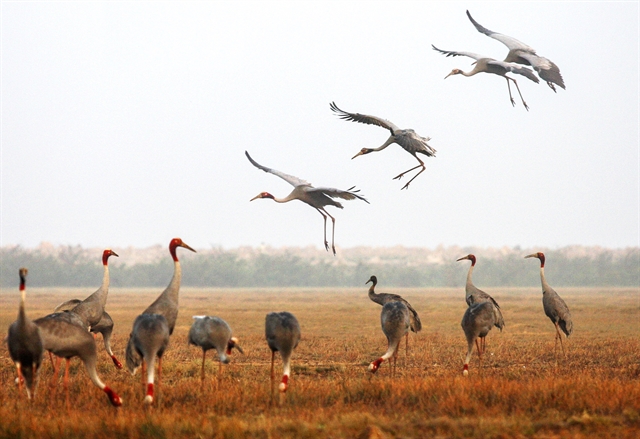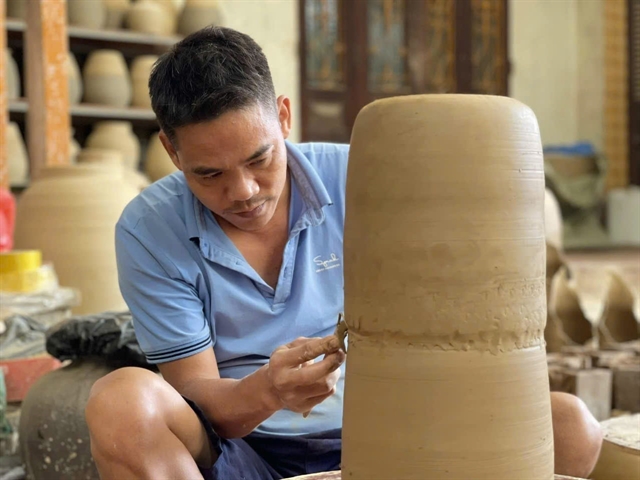

The festive atmosphere is reflected in a paintings depicting young men and women playing games such as catching eels, swing and blind man’s buff.
 |
| Wild animals: The five tigers, whose different colours correspond to spatial directions; yellow (centre), white (West), black (North), green (East) and red (South). |
HÀ NỘI — The festive atmosphere is reflected in paintings depicting young men and women playing games such as catching eels, swing and blind man’s buff.
Festival is one of the themes in folk paintings being displayed at a new exhibition in Hà Nội.
The exhibition, titled Vietnamese Folk Paintings, showcases 50 works of art on diverse topics, from daily life, religious practices, literature, and seasons, as well as historical stories.
Visitors can enjoy paintings depicting daily life, beautiful girls, landscapes, religion and those inspired by literature such as Kiều’s Tale by Nguyễn Du.
The show is organised by the Thăng Long – Hà Nội Heritage Conservation Centre and the French School of Far Eastern Research (Ecole Française d’Extreme Orient – EFEO) in HCM City.
The paintings at the event were selected from the book Vietnamese Folk paintings - Collection and Research by Maurice Durand, head of the EFEO from 1947 to 1957.
These paintings are high quality copies of the originals, provided by Marcus Durand, son of Maurice Durand.
The book was published by the EFEO in the 20th century, introducing a large part of the collection of more than 400 folk paintings collected by Durand in Hà Nội from 1940 with the support of Vietnamese and French scholars such as Trần Văn Giáp, Trần Huy Bá, Louis Bezacier and Paul Lesvy.
Born in 1914 in Hà Nội, Durand Sr was the son of a French sinologist and a Vietnamese woman. He was a historian, literary language expert and critic, and art analyst. Durand is one of the rare bilingual researchers of the EFEO, with knowledge of French and Vietnamese cultural sources which are closely related to the Han Chinese script.
Trần Việt Anh, director of the Thăng Long – Hà Nội Heritage Conservation Centre, said folk paintings are a precious cultural heritage that should be respected and preserved.
“The collection of Durand is exceptional because most of the paintings were preserved perfectly. It’s unique as there is no other collection as diverse and abundant.”
Visitors can enjoy Đông Hồ, Hàng Trống and Kim Hoàng paintings – the most popular genres of folk paintings. The techniques and tools used to produce the paintings are also introduced.
Hàng Trống art is traditionally produced on paper with one carved woodblock inked in black to give an outline that is then filled in with different colours by hand. Its artistic cousin, Đông Hồ, is produced by a series of woodblocks, each carrying a different colour.
The paintings are used for worship, displaying everyday and during the Lunar New Year festival.
Bắc Ninh Province’s Đông Hồ folk paintings are about children, rural life and farm animals, and Hà Nội’s Hàng Trống woodcuts feature heroic figures, such as Trần Hưng Đạo repelling the Mongols, as well as landscapes and beautiful girls.
While Kim Hoàng painting (Hoài Đức District, Hà Nội) combine the best of two kinds of paintings, it has more delicate, detailed lines than Đông Hồ paintings, and the colours are as bright as that of Hàng Trống paintings.
The most noticeable trait of Kim Hoàng is that craftsmen use only one woodblock to print the black outline onto the paper, while the rest of the colour is filled in by the craftsmen, making each painting a unique work of art.
Currently, an exhibition on documents, photos, and paintings relating to the former Governors of Hà Nội – Nguyễn Tri Phương (1800-1873) and Hoàng Diệu (1829 - 1882) who fought to protect the capital during the semi-feudal colonial time, is on going at Cửa Bắc Gate relic site, a part of the Thăng Long Imperial Citadel.
The exhibition highlighted the role of the two famous generals who commanded the army and civilians in fighting against French colonialists in Hà Nội in the 1800s.
The exhibitions will run until September 30 at the Thăng Long Imperial Citadel, 9 Hoàng Diệu Street, Hà Nội. — VNS
 |
| Worship: A Hàng Trống painting featuring a traditional altar of the Vietnamese people. |






 brought the story behind the evolution to life for more than 270 global and local suppliers—highlighting how the brand reflects the company’s bold ambitions and purpose-driven growth.)


)